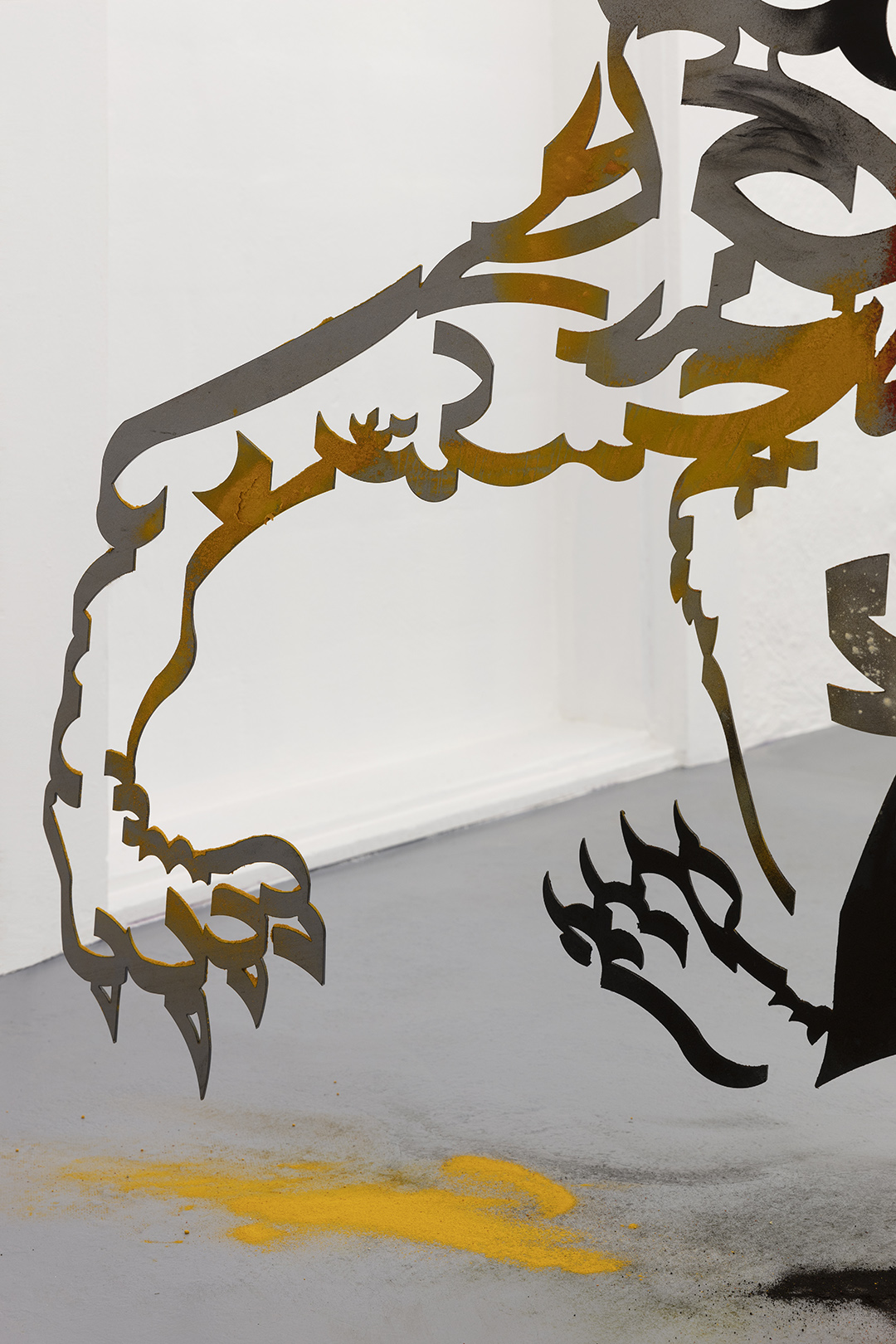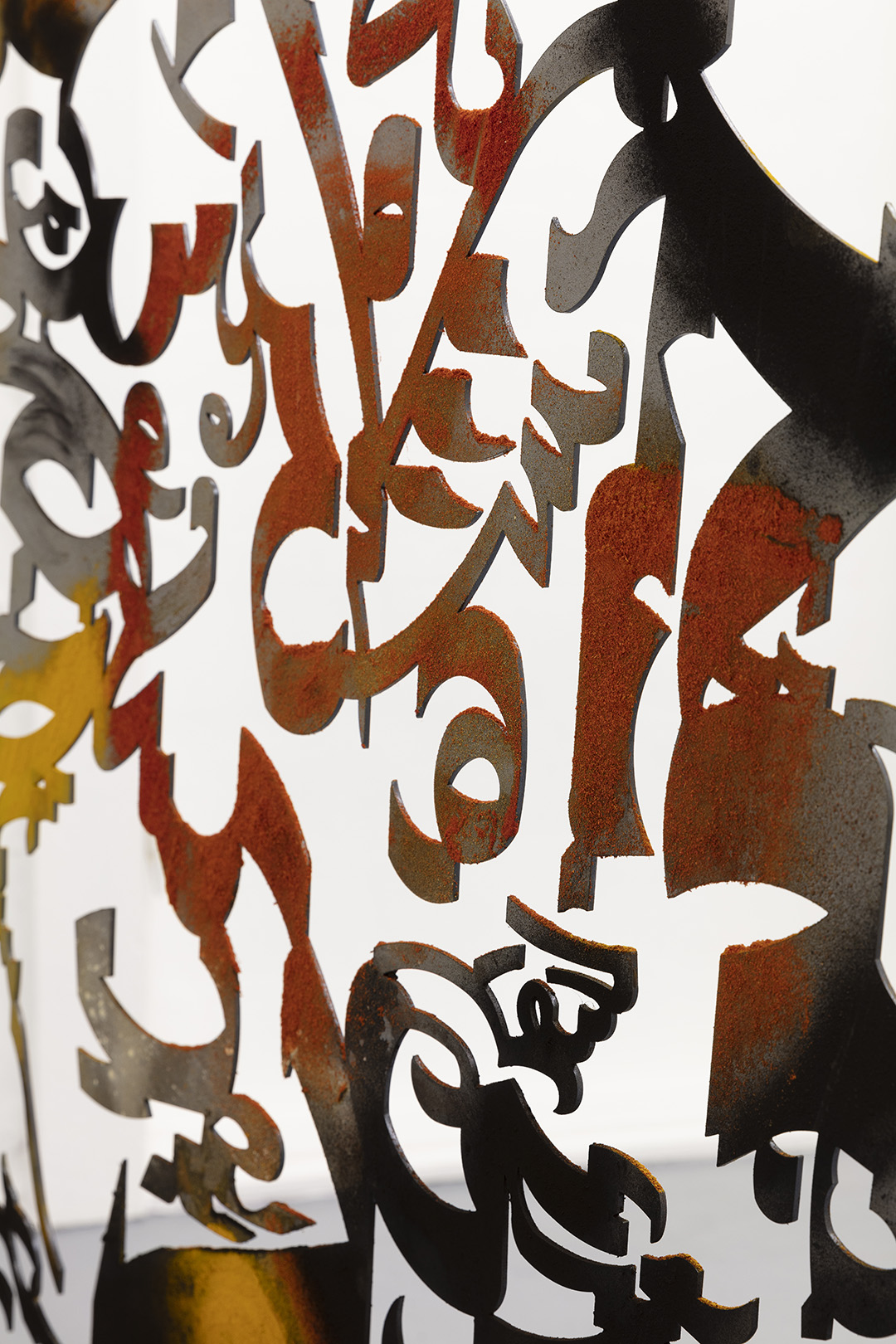
By Pia Diamandis & Elena Tortelli. Cover image: Monia Ben Hamouda, Aniconism as Figurative Urgency (I thnan) [left], Aniconism as Figurative Urgency (Thalaathah) [right], 2021. Laser cut steel, spice powders. Photo: Andrea Rossetti. Courtesy of the artist and BUNGALOW/ChertLüdde, Berlin
“A Feminine Lexicon” artists include Milan and al-Qayrawan-based visual artist Monia Ben Hamouda (b. 1991, Milan, Italy). Her work navigates and confronts the human condition using sculpture as a tool to reinterpret and reappropriate her cultural genealogy.
In “A Feminine Lexicon”, Monia Ben Hamouda showcases Aniconism as a Figurative Urgency (2021). A series of laser-cut steel sculptures covered in spices compose a metamorphosis still underway, where the transformation into a calligram will never be complete like an Apollo and Daphne made up of signs alone. They form the outline of a dog camouflaged in the memory of a written alphabet, without ever producing forms that can be uttered as spoken words.
Monia Ben Hamouda’s Aniconism as a Figurative Urgency is featured inside the exhibition “A Feminine Lexicon” underneath the section Kins, chosen to underline the links, bonds and connections that we make, as Donna Haraway suggests, inside and outside our blood ties.
The section Kins features works by Monia Ben Hamouda, Helena Hladilová, Lebohang Kganye, and Alice Visentin.

PD, ET: How would you best describe your series Aniconism as a Figurative Urgency? Where did the idea to make them come from?
MBH: My father is an Islamic calligrapher. I found it very important, very formative, to see how art and art history were viewed within my family and my culture. What was allowed, what was forbidden, and how I could move in that environment, trying to balance the western view of art history that I was taught at school and the one my family, and the artists in my family, valued.

Religion, figuration, geometry, and calligraphy are all part of my language and have always been a filter through which I approach art. The way I was brought up to know art, the way art history was seen in my family, what I saw my father do every night on his drafting table, these are the aspects that have shaped my vision and are now the guiding elements of all my work.

PD, ET: As we consider your work deeply rooted in the kinships and bonds that you are continuously creating inside and outside your family enviroment, what is your relationship with traditions, memory and family ties?
MBH: Representation is the underlying theme of this series of sculptures. It is a subject related to my personal history and my family’s identity.
Islamic art is made up of both geometric and symbolic elements: calligraphy is central, as figurative art is forbidden by religion. Islam is an aniconic religion, so figurative art, and representing icons or images depicting living beings or religious figures, is strongly forbidden. This dogma is particularly significant for Islamic artistic traditions.

However, some examples of Islamic art that is both figurative and abstract can easily be found. Indeed, through another strategy, using geometry and calligraphy, Islamic artists and calligraphers succeeded and still succeed in their attempt at representation, only accepted if filtered through this abstraction. […] My sculptures are thus an attempt towards remaining faithful, and true to oneself. They are drawn from the heritage of Islamic art, but with the idea that the urgency of figuration, the urgency of art to self-renew is strong. […] The environment in which I grew up and the one from which I was excluded have always been a burning source of enquiry for me.
INFORMATION
A Feminine Lexicon is an online exhibition curated by Pia Diamandis and Elena Tortelli, students in Arts Curating at Istituto Marangoni Firenze for Museo Salvatore Ferragamo, available at museo.ferragamo.com.
Monia Ben Hamouda is a visual artist. She lives and works between al-Qayrawan and Milan.
Pia Diamandis and Elena Tortelli are undergraduate students of Arts Curating at Istituto Marangoni Firenze.



